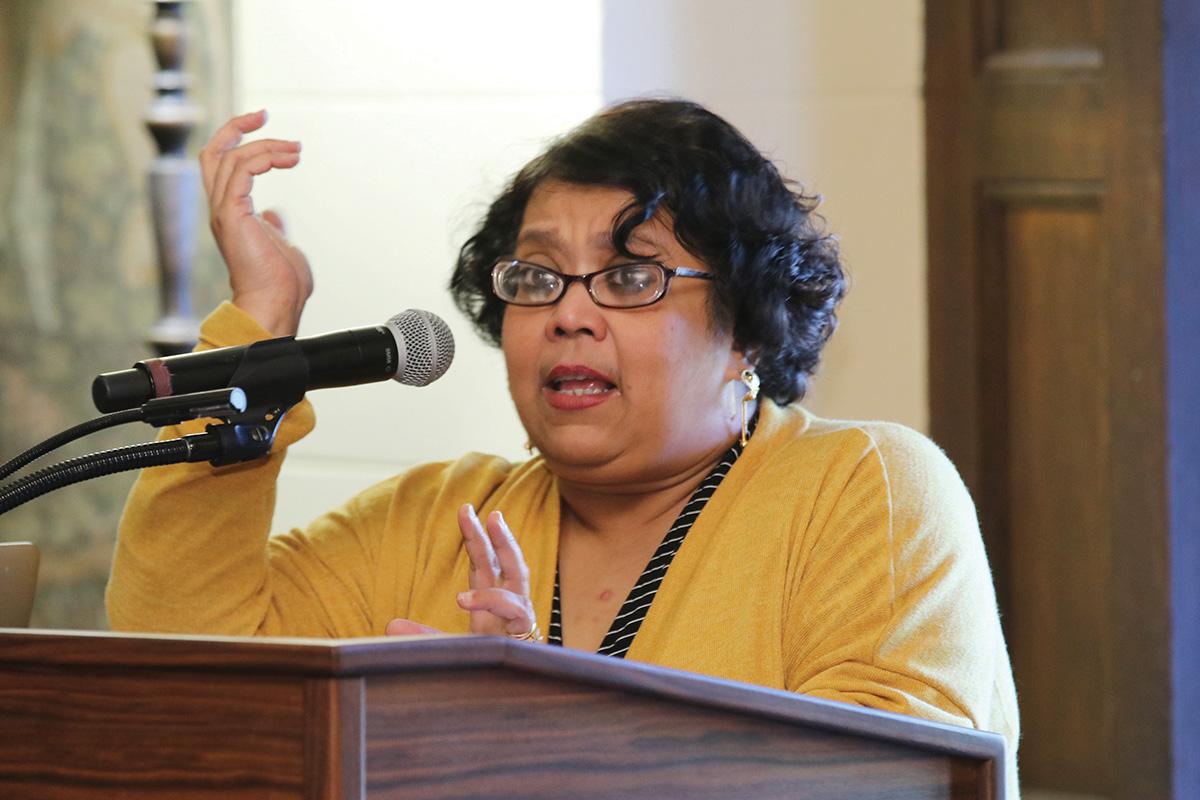
Interview by Jenée Wilde, Senior Instructor, Department of English, CSWS Dissemination Specialist
With a background in comparative media studies and postcolonial theory, Associate Professor Sangita Gopal came to the University of Oregon in 2004 to teach cinema studies in the Department of English. Over time she saw the popular program grow from an English concentration into a unique tri-school major, then into its own department housed in the College of Arts and Sciences.
Gopal’s research centers in media’s social dynamics, especially on questions of gender and sexuality. More specifically, her research combines the sociology of media with industrial studies in order to understand how the two interact and create certain narratives and generic structures, particularly regarding gender. Her first book, Conjugations: Marriage and Form in New Bollywood Cinema (University of Chicago Press, 2011) looked at how the thematization of marriage shifted in Indian cinema during a certain moment of social, cultural, and industrial transformation in the 1990s.
Supported by two CSWS faculty research grants, Gopal is completing her second book, tentatively titled Mixed Media: Women’s Filmmaking in India in the 1980s. During this period, more women filmmakers came to the fore across language cinemas and genres, as well as into the mainstream. While the traditional approach has been to link women filmmakers in this period to the women’s movement and to barriers for women in the filmmaking industry, Gopal’s interest is in understanding the ways in which gender as a focus of social attention enabled women filmmakers to take advantage of lower barriers into new media—specifically, television media across terrestrial, cable, and satellite platforms. The book explores how Indian women filmmakers negotiated certain industrial and media environments that bring a prominence to them because the women’s question is being discussed more broadly. Her primary interest lies not in social and industrial conditions that prevented women from getting their work done, but rather in the conditions at the time that enabled women to pursue their creative work.
I spoke with Sangita in August as she was working on her book, negotiating summer childcare for her twelve-year-old daughter, and gearing up for her new role as interim director of CSWS:
Jenée Wilde: When do you expect to finish your book?
Sangita Gopal: Next March is my goal, and it’s a goal because the pandemic disruptions make such targets really hard. This month, my daughter was supposed to be in camp the whole month, and then they cancelled. So you go from a situation of imagining where you can work all day to, what should I do now?
JW: You came to the university in 2004. When did you start getting involved with CSWS?
SG: Pretty much right away. I was told about CSWS during the campus visit since I have a research interest in gender. As soon as I got here, I was invited to some kind of reception or social event. The director of CSWS was Sandi Morgen and I felt really welcomed right away. At the time, Sandi had done so much interesting work on issues around gender and labor. When I was hired, several others in my cohort also had interests in gender—people like Pricilla Ovalle, Cecillia Rangel, Gabriella Martinez, and Michelle McKinley. We all had more global and international interests but also in issues concerning women of color. Sandi was really interested in including this new research and these approaches into CSWS, and so it was a really vibrant community. I feel very fortunate that I came in at that time with that cohort.
The second year of being here, I was invited to serve as an evaluator for graduate student grants, and that really gave me a very intimate look into the inner workings of the Center, especially as it related to supporting student research. It was a very good experience working with my senior colleagues, for the first time really, looking at all this wonderful research.
The next year, Sandi invited Lamia Karim and I to put on a conference called Empire. It was really a massive undertaking, and I feel as a junior faculty member I never should have done it because it was very time-consuming. So that’s the piece of advice I would give if I were mentoring anyone: Don’t put on a conference in your third year of tenure track. But the upside was that it was a fantastic conference, and I made so many contacts—such a rich network opened up before me. I felt deeply connected to the Center as a result of having done that.
Soon after, my work with the Center began to shift gears into the Women of Color Project, which took off in 2007. We received a Ford Foundation grant and Lynn Fujiwara came out of sabbatical to lead that project because there were no other tenured women of color faculty. That original Ford Foundation grant was to encourage women of color leadership within the university. From then on, my major involvement has been, up to now, with that Women of Color Project, which has gone through various cycles. Lynn led it for a few years until the grant was spent. Then CSWS took it on as a special project and the brief broadened from just leadership to promoting and supporting a cohort in research, retention, et cetera.
For some reason, while we were a very active, engaged, and energetic group, our abilities to build on our agenda turned out to be quite limited, in terms of not having that much success with retention or even recruitment at that time. I think a part of that was the broader institution did not take this on as a priority, so we were working in silo fashion. What the Women of Color Project became—and this is really important—it became a very vital cohort and team-building initiative for us to really feel like a group that supported each other both intellectually as well as in terms of providing mentorship, helping younger faculty members get acclimatized, et cetera.
When Michael Hames Garcia became the director, there was an opening for an associate director. I got the position and decided to restart the Women of Color Project, partly because I was at an event around 2014 and I realized, oh my God, there were only two woman of color full professors at the university—one who actively came to events and one who didn’t. I thought, this is really ridiculous and we really have to work harder to do something about this.
CSWS’s funding for the Women of Color Project was lapsing, and the director at the time felt it wasn’t something the Center could continue to support at those levels. So we approached the president and received a three-year grant, which has since been renewed. I served as the convenor for that project for five years, and I think we had quite a good ride.
I agreed to step in as interim director when Michelle, who had worked incredibly hard as director for the Center, needed to go on sabbatical. I felt like this would be something that I could do for a year to support Michelle. It was also during the pandemic, and it seemed like searching for a new director would be quite challenging, given all the other constraints. Given my long association with the Center, I felt up to the task of doing it for a year.
JW: What are you thinking about doing for this period while you are interim director? What are your goals? Do you have anything specific you want to see happen in terms of preparing for someone coming in long-term?
SG: Going in, I really see the next year as being one where we hopefully transition out from the pandemic more than last year—I say hopefully because who knows how long it will take. But I have three goals, really: to help make that transition as smooth as possible; to think about the internal structure of the Center and if our current levels of staffing are adequate; and to plan for the 50th Anniversary celebrations coming up in 2023.
My impression is that people at the Center work incredibly hard and we don’t have enough staff to get done what we need to get done, so it makes it very burdensome on the people who are there. I see my second goal as to address that staffing issue and to get us more staff and support so whomever comes into this position next has a full house administratively. I also realize I’m coming in at a time when—owing to the pandemic and all the disruptions, as well as the new models of administrative staff support that have been proposed across the university—everything is up in the air. I’m going to see how the Center’s need for staffing and smooth operations can be best articulated with wider developments in the university so we retain the autonomy that we absolutely need as an endowed center with a very specific project that doesn’t really align with anything else on campus. I see my main task this year as trying to preserve that vision and providing the kind of staffing that will allow that vision to be preserved. I’m fully aware that there are broader structural changes at work, and how to have CSWS come out best from that is going to be a big part of my focus.
As interim, I don’t want to make any brand-new programs or create new projects because that will be for the next director to do. I definitely see that this year is one of transitioning out of the pandemic and making sure that the Center’s operations are strengthened as we start planning for the 50th Anniversary celebrations. A lot of in-house things I imagine will be happening this coming year.
JW: Thinking about the Center, our affiliates, and the impact of the pandemic on what we’ve been able to do during this period, do you have any last thoughts about our role and how we’ve been able to support our affiliates through this crisis? What do you see happening moving forward?
SG: I think the Center has really been a great resource for support because of the Caregiver Campaign as well as all the special projects we’ve been able to initiate and support around that. At the same time, I don’t see the need for support ending anytime soon. Whatever the pandemic being “over” means, the research impact on our affiliates is going to last several years. So even in the best-case scenario of the pandemic being effectively over in the coming year, which doesn’t seem likely right now, we’re looking at two or three more years of research impact.
I see the Center continuing to do the incredible advocacy and information-gathering work it has done to make sure this issue stays on the radar for units and departments and supervisors, to make sure that what is by now clearly demonstrated in multiple studies—that there are unequal, gendered impacts of the pandemic not only on women but on women of color particularly—that we continue to make this a priority as we move forward. The act of documentation I see to be a really important and continued focus—of documenting what that research impact has been through accounts from our affiliates and bringing it to the attention of the university community as well as the university administration more broadly.
Even for that purpose, our infrastructure is really slim. The very fact that we took the Caregiver Campaign on voluntarily, even though we had very little ability to do so, is precisely the problem. Being CSWS, we have exactly the same symptoms of women faculty everywhere, which is that we do too much for too little. I feel like the Center should try to reverse that pattern of having an undue share of labor fall on women and to look at this issue both internally and more broadly.
—Jenée Wilde is a senior instructor of English and research dissemination specialist for CSWS.

